The Indian Ministry of Civil Aviation has moved to address the issue of significant congestion at India’s major airports, including Delhi and Mumbai.
As travel and passenger movements grow, the Ministry of Civil Aviation has outlined a number of initiatives which it intends to implement at major airports.
Civil aviation initiatives
Decongesting major airports in India, such as Delhi and Mumbai, has become a significant issue. Crowded terminals, long queues, and traffic congestion have become common problems that passengers are now facing.
To tackle these issues, several measures will be taken by the airport authorities to make air travel a smooth and hassle-free experience for passengers. These measures will ensure that passengers do not face any significant inconvenience while traveling.
Traffic marshals
One of the measures taken by the airport authorities is the deployment of additional traffic marshals at the departure forecourt. These marshals ensure that there is no vehicular congestion, which can cause delays and lead to chaos at the airport.
Information signage
To guide passengers in advance, display boards have been put up at vantage points. These boards show the least waiting time along with the entry gate number.
Additionally, display boards have been installed at entry gates that provide real-time data on waiting time. This information is also shared via social media to keep passengers informed.
Awareness posters have been put up at entry gates, urging passengers to be ready with their air tickets, boarding passes, and identity proof documents. Dedicated staff has been deployed to help passengers with any queries or difficulties they may face.
Additional entry gates
To cater to the growing number of passengers, additional entry gates have been opened. At Delhi airport, a new security zone called Zone 0 has been created inside Terminal 3. This has led to a significant reduction in waiting time for passengers.
Installation of new X-ray machines
The installation and commissioning of additional X-ray machines for baggage check has addressed the bottleneck at security points.
At Delhi airport, 15 additional X-BIS machines have been added, taking the total number of X-ray machines to 25 in T-3 Domestic and 19 in T-3 International.
Similarly, at Mumbai Airport, three new security lanes have been added to reduce waiting time for passengers.
To further reduce waiting time, the Mumbai airport operator has commissioned a Domestic to Domestic (D2D) transfer facility.
Security upgrades
This has cut down the minimum connection time for transfer of passengers and crew members and added flexibility to airline operators in planning their flight schedule and rostering of crew members.
The deployment of additional manpower by the Central Industrial Security Force (CISF) has been ensured. The use of CCTV and Command Centre has been increased for monitoring the situation. Additionally, the use of Count Meter for crowd management has been implemented.
Slot time and arrivals management
Airport operators have been advised to re-balance peak-hour traffic between terminals by shifting slots to optimise flights during peak hours. Airlines have been advised to deploy sufficient manpower at all check-in and baggage drop counters.
Incoming international passengers are encouraged to fill the Disembarkation cards on board. Manpower is being deployed by India airport operators at disembarkation points to assist passengers in filling out the form.
To enhance the travel experience, air travellers are encouraged to use DigiYatra, a Biometric Enabled Seamless Travel experience based on Facial Recognition Technology. In-flight announcements are being made to encourage the usage of the DigiYatra platform.
To facilitate automated entry, 2D Bar code scanners have been installed at all entry gates. Airlines have been advised to comply fully with the barcode on tickets issued to help the easy flow of passengers at entry/security gates.
Summary
To ensure compliance with these measures, daily monitoring is now being conducted at the level of airport operators, airlines, and also the Ministry of Civil Aviation. These measures are implemented with the utmost consideration for maintaining airport security.









